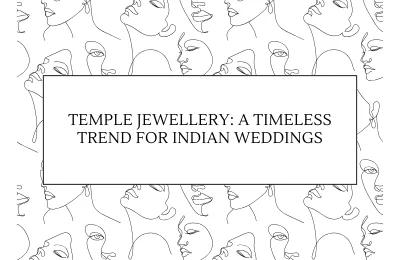Temple Jewellery: A Timeless Trend for Indian Weddings

Introduction
Indian weddings are a magnificent display of culture, tradition, and grandeur. Every element, from the bride’s attire to her jewellery, plays a crucial role in crafting a stunning bridal look. Among the many jewellery styles available, temple jewellery stands out as a timeless and elegant choice for brides.
Temple jewellery has its origins in South India and is known for its intricate craftsmanship, divine motifs, and association with spiritual traditions. This jewellery style, often crafted in gold and adorned with precious gemstones, has transcended generations and continues to be a significant part of Indian bridal trousseaus.
In this comprehensive guide, we will explore the history, significance, types, styling tips, and modern trends in temple jewellery, helping brides and wedding attendees make informed choices.
History of Temple Jewellery
Temple jewellery dates back to the Chola and Pandya dynasties of South India. Initially, this jewellery was crafted for adorning deities in temples, hence the name. Over time, temple jewellery became an integral part of dance forms like Bharatanatyam and Mohiniyattam, symbolizing grace and divinity.
In ancient times, temple jewellery was made using pure gold, featuring motifs of gods, goddesses, and celestial beings. The royal families and aristocrats later adopted this jewellery style, making it a symbol of prestige and devotion. Today, temple jewellery is not only worn by classical dancers but also by brides who want to add a touch of tradition and elegance to their wedding look.
Significance of Temple Jewellery in Indian Weddings
Temple jewellery is deeply rooted in Indian culture and spirituality. It represents blessings, prosperity, and divine protection. Brides who wear temple jewellery are believed to invoke the blessings of deities for a blissful married life.
Apart from its spiritual significance, temple jewellery is also a symbol of heritage and family legacy. Many families pass down temple jewellery pieces from one generation to another, making it a treasured heirloom. The intricate craftsmanship and timeless appeal make it an essential part of Indian weddings.
Types of Temple Jewellery
Temple jewellery comes in various forms, each crafted with intricate designs and traditional motifs. Here are some of the most popular types:
1. Necklaces
- Choker: A close-fitting necklace adorned with goddess motifs and gold beads.
- Haram: A long, layered necklace with intricate patterns and large pendants.
- Mango Mala: A traditional necklace featuring mango-shaped designs embellished with rubies and emeralds.
2. Earrings
- Jhumkas: Bell-shaped earrings with gold and gemstone embellishments.
- Kaan Chain: A decorative chain attached to the earrings and pinned to the hair.
3. Bangles & Bracelets
- Kadas: Heavy gold bangles with intricate carvings of deities.
- Vanki: Armlets worn on the upper arms, often adorned with peacock or Lakshmi motifs.
4. Rings & Nose Pins
- Toe Rings: Symbolizing marital status, often studded with precious stones.
- Nath: A traditional nose ring with temple jewellery detailing.
5. Waist Belts & Hair Accessories
- Oddiyanam: A gold waist belt worn to accentuate the saree drape.
- Maang Tikka: A forehead ornament with a deity pendant, adding a regal touch.
How to Style Temple Jewellery for Your Wedding
Brides and wedding guests can style temple jewellery in multiple ways to create a regal look. Here are some expert tips:
- Bridal Look: Pair a heavy temple jewellery choker with a long haram necklace for a grand appearance. Complement with jhumkas, vanki, and an oddiyanam to complete the traditional South Indian bridal look.
- Contemporary Fusion: Wear a temple jewellery choker with an Indo-western outfit like a saree gown or lehenga for a modern touch.
- Minimalist Approach: Opt for statement temple jewellery pieces like a single haram or jhumkas for a minimal yet elegant style.
Modern Trends in Temple Jewellery
Despite its traditional roots, temple jewellery has evolved with modern influences. Some emerging trends include:
- Polki and Kundan Work: A blend of temple jewellery with North Indian Kundan and Polki designs.
- Lightweight Jewellery: Contemporary brides prefer lightweight temple jewellery for ease and comfort.
- Antique Finish: Vintage-style temple jewellery with an antique gold finish is gaining popularity.
- Silver Temple Jewellery: Silver variations with oxidized finishes are a favorite for pre-wedding events.
Buying and Maintaining Temple Jewellery
When investing in temple jewellery, ensure authenticity by purchasing from reputed jewellers. Here are some tips for maintenance:
- Store in a soft cloth or pouch to prevent scratches.
- Avoid direct contact with perfumes and chemicals.
- Clean with a soft brush and mild detergent to maintain its shine.
Conclusion
Temple jewellery continues to be a cherished part of Indian weddings, symbolizing tradition, divinity, and elegance. Whether you are a bride or a wedding guest, incorporating temple jewellery into your attire can enhance your look and connect you to India’s rich cultural heritage. As trends evolve, temple jewellery remains timeless, making it a must-have for every wedding celebration.
Whether you prefer a classic traditional style or a fusion look, temple jewellery offers something for everyone. Investing in these intricate pieces ensures that you not only look stunning on your big day but also own a timeless heirloom to pass on to future generations.
